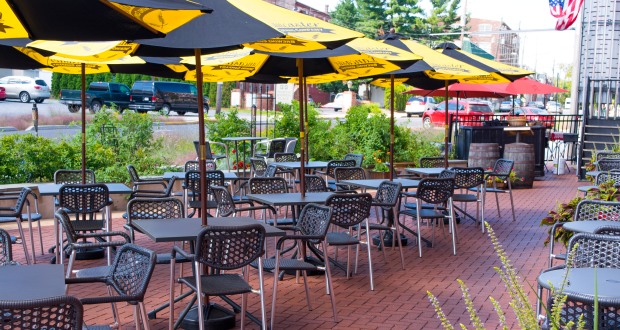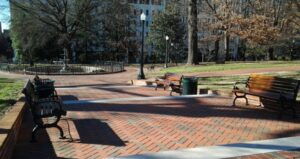Paving the Way to Environmental Change
By Walt Steele

The Chesapeake Bay is the largest body of water of its kind in the United States, with more than 150 major rivers and streams from six states and the District of Columbia flowing into its drainage basin.
It’s in trouble, and has been for a long time.
With its stock of crabs and oysters — and businesses that earn their living from them — declining in numbers, the Chesapeake is a visible example of what happens when water pollution continues unabated upstream for decades.
Most would agree that problems with water quality within the Chesapeake are the outcome of unintentional actions, which were caused in large part by a collision between aging infrastructure and population growth. Many cities, especially those settled long ago, combined stormwater runoff with septic sewer, which in today’s world can mean an increase in volume on both.
More people means more toilets, more showers, and more washing machines. That’s on the septic sewer side. More people also means more stormwater: More streets and parking lots and buildings, which increases stormwater runoff since more open land — where rain and snow melt used to go and be absorbed into the ground — has been paved over.
More of both, mixed together and feeding into the same pipe, means more of a burden on sewage treatment plants that were built when the population was much lower; more of a chance for a toxic spill into waterways; and ultimately, more cost to the taxpayer.
What’s needed is less — and that’s what two projects, one to the north and one to the south of the Chesapeake — have undertaken.
Two rivers
The story begins with two rivers: the Susquehanna River flows into the Chesapeake in the north; the James River in the south.
Two projects, one tied to each river, have been put into place to lower stormwater volume going into sewer systems. Both use StormPave permeable pavers, by Pine Hall Brick Company, which enable rainfall and snow melt to penetrate through the pavement surface. From there, it either seeps into the ground, where it is naturally filtered, or it is captured into tanks for irrigation.
The Susquehanna
In Lancaster, Pa., the combination of stormwater and sewage can overwhelm the treatment plant on a rainy day, which results in pollution being released into the Conestoga River, then into the Susquehanna, and finally into the Chesapeake Bay.
The installation of the StormPave pavers was one of the key features in an upgrade of the intersection of Plum and Walnut streets in Lancaster. In 2014, the Chesapeake Stormwater Network announced that the project won the Grand Prize — the Best Urban BMP (Best Management Practice) in the Bay Award, or BUBBA.
The stormwater network — which is made up of nearly 4,000 stormwater professionals throughout the Chesapeake Bay Watershed, which runs from New York south through several states to Virginia — began the competition to recognize innovative approaches to handle stormwater.
The network noted that the project effectively transformed a low-lying intersection that had a large concrete island and a dangerous merge lane into a model for stormwater management, enhanced pedestrian amenities, improved traffic safety and increased commercial activity. A large outdoor dining patio and diagonal parking spaces, both with StormPave pavers, were built at the Lancaster Brewing Company.
The once concrete-and-asphalt intersection is now home to native shrubs, perennials, ornamental grasses and new tree species surrounding the outdoor café (see photo above). Adjacent to the dining patio is a sculpture with a framework of steel and irregular native woods that hides a 700-gallon cistern. The installation captures stormwater from the roof for watering planters that are used by the brewery’s owners to grow their own produce.
John McGrann, owner of Penn Stone, a Pine Hall Brick Company dealer, said that the use or permeable paving is seeing increased popularity in the area around Lancaster, in part because of environmental concerns.
McGrann said the project at Plum and Walnut makes good economic sense, on a couple different levels. He said that the City of Lancaster is under a mandate from the federal Environmental Protection Agency (EPA) to either come up with a way to solve the problem, or the EPA will require the city to build a series of expensive gray-water holding tanks. The tanks are designed to hold the wastewater long enough to give the treatment plant time to treat all of it before it’s discharged into the river.
“We can either spend the money or we can explore the alternatives that are out there,” said McGrann. “We can get in compliance with the EPA requirements through a strategy of green infrastructure for half the investment and create some interesting infrastructure in the process.”
Early examples, in addition to the intersection project, have included the use of porous pavement (instead of solid asphalt) to build basketball courts, and a combination of porous pavement and permeable pavers to replace an alleyway, McGrann said.
“From what I hear, we’re getting held up as an example of discovering good solutions instead of being confrontational and getting forced into a bad solution,” said McGrann.
The James River

To the south, in Richmond, Virginia, a similar story is taking shape. Richmond, one of the oldest cities in the United States, also has a combined stormwater and septic sewer system.
A project is underway on the grounds of the Virginia State Capitol that uses a combination of new technology and old infrastructure.
Sited on Shockoe Hill, which overlooks the falls of the James River in downtown Richmond, the Virginia State Capitol building looks very similar today to the way its designer, Thomas Jefferson, envisioned it. Modeled after an ancient Roman temple in southern France, the stark white building has played many roles.
Since 1792, it’s been the seat of government in Virginia; served for a short time as the Capitol of the Confederacy during the Civil War; and is even sometimes used as a stand in for the White House for exterior shots for television and movie productions.
Today, the capitol’s grounds and adjacent streets and alleys are in the midst of a project that is using a mix of environmental design changes, including permeable StormPave pavers from Pine Hall Brick Company. The project is an effort to protect the river which Jefferson admired from that hilltop more than two centuries ago.
The “Greening Virginia’s Capitol” project has brought together both governmental and environmental groups — including the Alliance for the Chesapeake Bay and the National Fish and Wildlife Foundation — with one goal: To use water wisely by conserving clean water and cleaning pollutants from runoff.
To lessen the demand on clean water, an existing underground tank that was originally installed to collect stormwater runoff is being modified to redirect stormwater into the irrigation system — thus reducing the demand on the public water supply during the spring and summer. And to reduce runoff being treated off site, the area of impervious surface on the grounds has been reduced to include a rain garden, green streets, rainwater harvesting and permeable pavers.
Planners say the changes are intended to reduce the amounts of nitrogen and phosphorus, two of the biggest sources of pollution in the James River and, by extension, the Chesapeake Bay.
Chris Hale, ASLA, LEED AP, who provided design services for the project, explained that the location of the capitol grounds was part of the reason for the project’s main goals.
“The proximity to the river was really a driving factor in improving the water quality,” said Hale.
Hale pointed out that an added plus to cleaning up the runoff is that there is less sewage treatment — and thus cleaner water — being discharged downstream.
A properly installed permeable paver system means that the water goes around the pavers and seeps into the ground underneath, where it is naturally filtered, instead of flowing across a solid surface and carrying pollutants to a storm drain.
The entire job was environmentally responsible, including disposal of the older, conventional clay pavers that were on site. They were recycled and turned into a brick aggregate. The visually similar StormPave pavers were used as replacements in some areas, with first-time installation in others.
“The new brick matched pretty well with what was out there,” said Hale. “We worked with the historic character of the brick that was there, which allowed us to do the permeable system.”
A review of both projects in Lancaster and in Richmond makes clear that they are working to make a difference. Environmentalists, government officials and local residents alike have praised both for their efforts in helping to find new ways to reverse years of decline in the Chesapeake Bay.
Observers say that while the two cannot be a full solution, they are a step in the right direction.
Walt Steele, is a recognized expert on clay pavers. He is paver business manager for Pine Hall Brick Company, America’s largest manufacturer of genuine clay pavers. The company has plants in Madison, N.C. and Fairmount, Ga. Its corporate headquarters is at 2701 Shorefair Drive NW, Winston-Salem, NC 27105. For more information, Steele can be reached at 800-334-8689, by e-mail at waltsteele@pinehallbrick.com and by fax at 336-725-3940. For more information, visit www.PineHallBrick.com.


